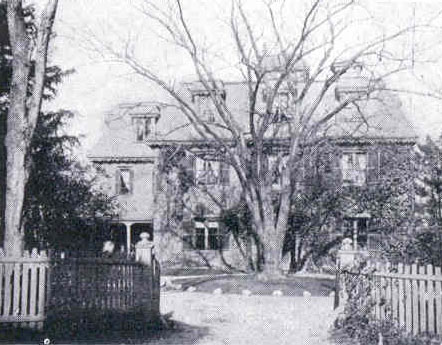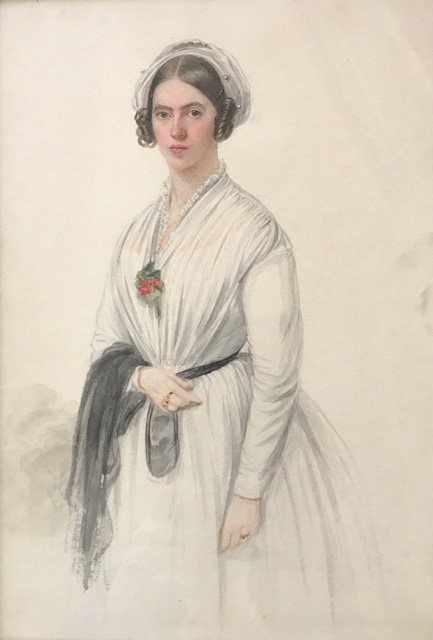Image: No. 2936 Home for Little Wanderers, formerly the home of the Industrial School for Girls, photograph September, 2003.

232 Centre Street
The Industrial School for Girls was founded in 1853 and incorporated in 1855 “for the purpose of training to good conduct, and instructing in household labor, destitute or neglected girls.” This was “the first reform school for girls” in the U.S. The brick school building, located on Centre Street, Dorchester, was constructed to house the school in 1859 to a design by architect George Snell. The Industrial School for Girls accommodated 30 girls from six to fifteen years old and trained them in good conduct and habits of self-support. Those who were received by the school generally came from homes which were broken up by the death of one or both the parents, or by desertion, or rendered unfit by drink or crime. The girls attended public school, and were besides thoroughly trained in housework, sewing, etc. On leaving the school for service, usually at age 18, the girls were generally placed in country families, where they might still be controlled to a certain extent by the managers of the school.
This is from the City archaelogist:
The Industrial School for Girls was built in 1859 at 232 Centre street in Dorchester. It remains standing to this day.
For much of its history, the school was occupied by up to 30 girls age 6-15. They came from disadvantaged backgrounds and were sent to the school to live year-round. The girls received an education and training for future work in domestic service. They were supervised by a matron and teacher. Many of the girls would leave the school when placed in a home for work. But, many of the girls were sent back for behavior and other issues.
The school was a female-only education site. The girls’ lifestyles were tightly regulated by a board of women. The board was made up of wealthy Boston women and the staff of the school. The board oversaw everything in the girls lives, including their dress, actions, and education.
For more about the archaeological dig, see
https://www.boston.gov/departments/archaeology/dorchester-industrial-school-girls
The following is from https://dorchesterindustrialschoolforgirls.wordpress.com/
In the fall of 1853, several women met in the home of Mrs. Lucy O. Bowditch with the purpose of establishing an Industrial School for Girls. These women wanted to create a place where young, disadvantaged girls could be properly cared for, receive an education, and be trained to work as domestic servants. Their goal was to “prevent evil” in the girls. They sought to:
“train these children to good personal habits; to instruct them in household labor; and to exert a moral influence and discipline over them which should fit them to be able and efficient in domestic service, or in any probable mode of gaining their own livelihood.”
By November first of that year, they had procured a large house in Winchester, Massachusetts and opened the school with one matron, one teacher and one student. By 1858, the managers realized the Winchester property was “inconvenient for so many reasons”. They were beginning to outgrow the space and a house was not conducive for a school. In June they bought the property at 232 Centre Street in Dorchester and hired a well-known Boston architect, George Snell, to design their new school, and William Rumrell to build it.
In January of 1859, less than six months later, the new building was completed and some thirty girls, the matron, and the teacher moved in from Winchester. The school contained a schoolroom, dining area, kitchen, laundry room, and playroom. The second floor housed rooms for the matrons and teacher, along with two dormitories—each equipped with sixteen single bedrooms from which the girls could see the Blue Hills or Boston Harbor depending on the location of the bedroom. The property itself was square-shaped, large, and open; it included a carriage house, an attached privy, open exercise grounds, and a Prospective students went through an application process. In order to qualify for admission, the girls had to come from destitute families. For many, this meant their parent(s) were unable to support them financially, were prone to drinking and/or were incarcerated. In other cases, the parent(s) were noted as ill, absent, or dead. By 1858, their popularity had grown such that for every one girl they accepted into the school, they had to turn away two. They felt it was important to “work thoroughly with a few than superficially for many.” When the school first opened, students accepted ranged in age from six years to fifteen years old, but by 1898 the directors raised the minimum age to eleven. Initially, the girls were educated, trained, and lived in the school, but by 1881 the girls began to attend Dorchester’s public schools and returned for their vocational training at the Centre Street property in the afternoons. The yard offered space for the girls to play and “not disturb the neighbors,” and accommodated their garden, which provided fresh food for their meals. Although the school did not affiliate with any religious organizations, the girls did attend the local Congregational Church.
The Dorchester Industrial School for Girls provided a unique system of individual guardianship. When the school placed girls into homes to work as domestic servants, they assigned each girl a guardian (usually a school manager), who checked in on the girl to make sure her placement was a satisfactory one. This relationship often lasted for years. This program was unusual, as most industrial schools ended their responsibility to their students once they left. The Dorchester school’s program was so unique that it was a topic of discussion at conferences and in professional publications.
Since it was built in 1859, the Industrial School for Girls building was continuously used as a school until it merged with the Home for Little Wanderers in 1941, changed its name to the Everett House, and implemented a new mission: to house girls who were in trouble with the law. In 2011, the Home for Little Wanderers sold the property to Epiphany School, Inc.—an organization that also serves economically-disadvantaged children. The Epiphany School has chosen to keep the historic building and build a new facility around the structure. Perhaps the historic school on Centre Street will now serve another 160 years helping and educating children.
UMass Graduate Program in Public History
On Wednesday, May 10, 2017, students of the Graduate Program in Public History at UMass Boston presented their research on the Industrial School for Girls and the girls and women involved in that institution. The event was also the launch of the website created by the students in the Graduate Program about the Industrial School.

The building used by the School is still in existence at 232 Centre Street. The building, which is owned by the Epiphany School, was the subject of a petition to the Boston Landmarks Commission for Landmark status. The Epiphany School now plans to preserve the building and has been building new facilities on the property to accommodate their expansion. In 2015, Joe Bagley, the city’s archaeologist recovered 17,723 historic artifacts from the site, many of which can be viewed in the website created by the graduate students.
The website is engaging and easy to use. It includes the stories of some of the girls who attended and some of the women who were involved with the school. A suggestion to include in the website a list of all the girls who are known to have attended the school was met with general approval. Including all the names, even when no information has yet been discovered about some of the, may invite others to contribute comments about some of these yet-to-be researched girls.
In one sense it is remarkable that the graduate students were able to find so much information about some of the students and staff. The girls were mostly from the lower-income level of society and were not the kinds of people who leave a lot of records behind. The frustration that the researchers felt when their research turned up very little about some of the people was heartfelt. Although their class project is over, it is easy to believe that some of these students will continue to be ever watchful for more evidence about the lives of their chosen subjects. So we may learn more as time goes on.
The stories of the women and girls are engaging. There are a good many images of artifacts from the archaeological dig and from the lives of the people. One additional feature is a list of resources consulted for each person for whom research was done. This is a great example of how we should all document our genealogical research.
The following is from the entry for Mary Parkman written by Caroline Littlewood, an entry within the website:
Mary Eliot (Dwight) Parkman served as President of the Industrial School for Girls from 1860 to 1862. Born January 23, 1821, Mary was the daughter of industrial pioneer and education reformer Edmund Dwight, and the granddaughter of shipping millionaire Samuel Eliot through her mother, Mary Harrison Eliot Dwight. She spent her early years in Boston and Chicopee, Massachusetts balancing the care of her younger sisters and chronically ill mother, the social responsibilities of the Boston elite, and a rigorous education in the humanities. These experiences fed her interest in health and sanitation reform and prepared her for a life of leadership.
To see more of her story, visit the website. You can leave comments on the website as well.
Source:
The Dorchester Book. Boston: George H. Ellis, Printer for the Branch Alliance of Christ Church (Unitarian), Dorchester, Mass., 1899.
King’s Hand-Book of Boston. Boston: Moses Corporation, 1889. 9th ed.
Thirteenth Annual Report of the Board of State Charities of Massachusetts. Boston, Mass., 1877.
Proceedings of the [Twenty-eighth] National Conference of Charities and Correction. Boston, Mass., 1901.

